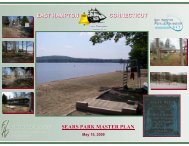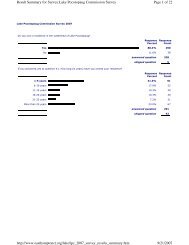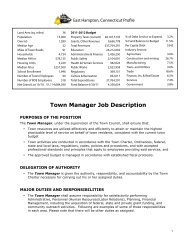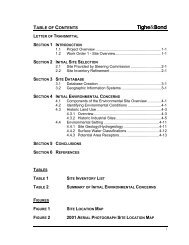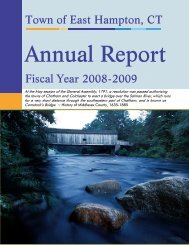Lake Pocotopaug Lake and Watershed Restoration Evaluation ...
Lake Pocotopaug Lake and Watershed Restoration Evaluation ...
Lake Pocotopaug Lake and Watershed Restoration Evaluation ...
You also want an ePaper? Increase the reach of your titles
YUMPU automatically turns print PDFs into web optimized ePapers that Google loves.
11.1 Reducing Non-Algal Turbidity11.0 POTENTIAL MANAGEMENT OPTIONSControl of non-algal turbidity requires underst<strong>and</strong>ing the sources <strong>and</strong> having the economicresources available. In the case of <strong>Lake</strong> <strong>Pocotopaug</strong>, the source of non-algal turbidity isunclear. Sediment loading is extensive <strong>and</strong> well documented. However, there is no significantrelationship between precipitation <strong>and</strong> in-lake turbidity. This is not to say that stormwater runoffdoes not contribute to in-lake turbidity or more importantly, to sedimentation (the infilling of thelake). What it does suggest is that an additional source may be present. <strong>Lake</strong> sediment in thesouthern portion of the lake may be entrained in the water column through wind action,distributing fine sediment throughout the lake <strong>and</strong> reducing water clarity. More data are neededto prove or disprove this theory, but observations suggest that this may be a substantial factor inlowered water clarity much of the year.If mixing is a source for decreased water clarity, management can be difficult. Changing windpatterns or mixing resistance is highly impractical. Dredging of the shallow areas to reducingmixing potential or the use of benthic barriers may help in this regard, but these measures areexpensive on a large scale <strong>and</strong> do not seem appropriate for <strong>Lake</strong> <strong>Pocotopaug</strong> at this time.Alum treatment of the southern area, avoided previously because it is not deep enough to havestrong anoxia <strong>and</strong> associated phosphorus release, may both help congeal the sediments to limitresuspension <strong>and</strong> inactivate any phosphorus that does get entrained in the water column. Thisapproach has seldom been tried, however, <strong>and</strong> is somewhat experimental.Sediment inputs should be controllable. The “Storm Water Renovation <strong>and</strong> Management Planfor <strong>Lake</strong> <strong>Pocotopaug</strong>” prepared by WMC in 1995 outlines many techniques for sediment inputreduction. The plan is provided in Appendix C for further reference. This section will notdiscuss each drainage basin <strong>and</strong> the techniques to employ, as the WMC report was fairlythorough, but it will give several options to consider for sediment reduction.Areas of concern are beaches (public or private), catch basins throughout the watershed <strong>and</strong>major tributaries (Christopher, Hales, Bay <strong>and</strong> O’Neill Brooks). Beaches might be provided witha vegetated buffer strip, although this is unpopular with beach goers. Alternatively, using thecoarsest possible s<strong>and</strong> for beaches will help, <strong>and</strong> covering the beach with filter fabric or settingup silt fence may be viable in the off-season. The most critical time is in the spring when thereis a high potential for runoff <strong>and</strong> beach attendance is minimal, but it may be necessary to takeaction in late autumn to ensure spring protection.Beaches are only a small part of the problem, however, <strong>and</strong> management of other watershedl<strong>and</strong>s will be essential to reducing solids inputs. Most alternatives for reducing sedimentation goh<strong>and</strong> in h<strong>and</strong> with phosphorus reducing techniques (a method of controlling algae). In an effortto avoid repeating sections, reduction of sediment <strong>and</strong> phosphorus will be discussed together inthe next section.<strong>Lake</strong> <strong>Pocotopaug</strong> <strong>Restoration</strong> <strong>Evaluation</strong> 93May 2002



